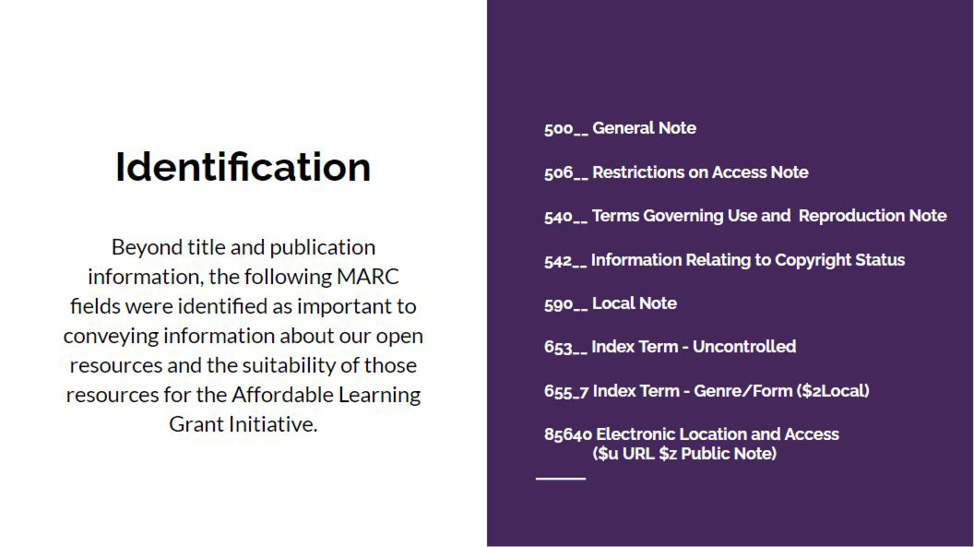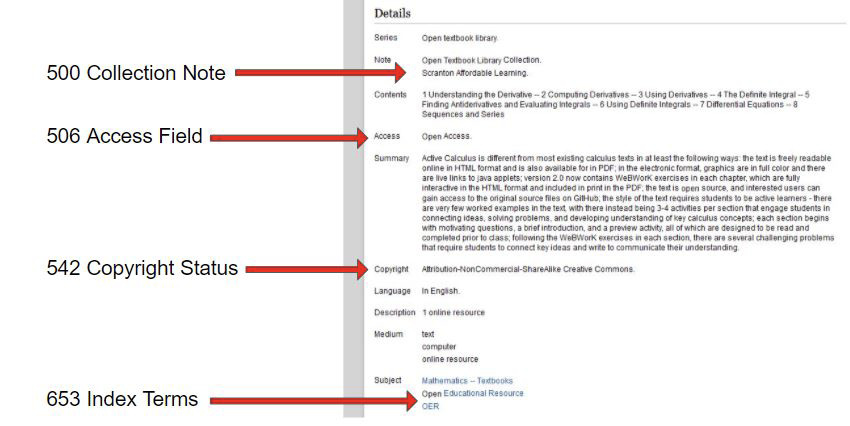Cataloging Collaborations: Supporting Affordable Learning Initiatives
Like many librarians, we often find ourselves answering the following question from students: Do you have my textbook? Unfortunately, in our case and many others, that answer is usually no. Over the last few years, librarians at the University of Scranton’s Weinberg Memorial Library have investigated ways to reduce textbook costs for students, including utilizing our library’s catalog to identify and promote open and licensed content for classroom use.
Our institution is a Catholic and Jesuit University in Scranton, Pennsylvania, which is in the northeast corner of the state. We enroll just under 5,000 students each fall, the majority being undergraduate students. In 2018, the University offered Strategic Initiatives Funding to applications for new projects to further the goals of their 2015-2020 Strategic Plan.
Two librarians, including author Kelly Banyas and an administrator, applied for and received Strategic Initiatives Funding to pilot a few initiatives encouraging faculty to investigate open resources as a way to mitigate course costs for students. We thought this fit nicely into the overall goals of the university’s strategic plan, which stated, “We will commit ourselves to remaining an affordable, accessible education that meets the needs and addresses the challenges of students from enrollment to graduation and beyond” (University of Scranton 2015). One of these funded initiatives was to pilot a $1,000 grant for faculty to replace for-cost course materials with open educational resources (OER) for the 2019-2020 academic year. We also decided to allow for the use of resources without digital rights management (DRM-free) in case faculty could not find discipline-specific OER. We specifically chose DRM-free resources to allow students to access the materials beyond the semester and encourage lifelong learning after graduation. As the project grew, the initial group evolved into the OER Committee, which added members within the library interested in becoming involved in the initiatives, including author Marleen Cloutier.
Our next major project was determining how to make such resources easily discoverable. Faculty had previously asked about the differences between types of e-book licenses and wondered why they could download so much of one book but only a small percentage of another. If we wanted to limit our grant recipients to utilizing library resources that could be simultaneously accessed and downloaded in full, we needed to find a way to make that explicitly clear in the item records. We did put together a LibGuide to organize links to OER platforms and specifically licensed or DRM-free library collections, but we were concerned that having to check so many places for resources could deter faculty from utilizing the resources in their courses. It was at this point that author Marleen Cloutier suggested the library catalog as a possible solution.
We started with a scan of our catalog and a discussion with our Acquisitions Librarian, who was able to point us towards collections containing resources that met our criteria. From there we needed to review and identify which MARC fields were being used to identify open and DRM-free resources. Utilizing the create lists function in our ILS, Sierra, we searched for MARC fields using the keywords Open Educational Resources, Open Access, Unlimited User Access, Unrestricted Online Access, and DRM-Free to see how and where these terms were being used. We also looked for references to Creative Commons licenses in fields 500, 540 & 542.
The scan of our catalog revealed that we had open access and DRM-free content readily available in the catalog; however, there was only a small amount of actual OER, and no OER created by our university faculty. For many records, it was unclear from the record if an item was an actual OER or just open access without a deeper dive into the resource, and there was a lack of consistency when it came to the noting of licensing information.
Before making changes in the catalog, we decided to do some reading to see if and how other institutions were working with their catalogs. Sobotka, Wheeler, and White identified the need to apply local rules and edits due to a lack of MARC standards related to OER and inconsistency in the metadata (2019, 19). Edmunds and Enriquez (2020) identified similar challenges when working to increase the visibility of their open access collections in their catalog. This is an issue because it makes additional work for catalogers. Choosing to make changes locally is exactly that: a choice. Deciding to make changes locally includes the need to maintain those changes over time, and that is something we needed to consider. One thing we decided on at the outset was that if we were going to invest the time, any local changes were only going to occur on records for items we owned or had permanent access to. We avoided making changes to subscription packages of electronic resources since there was a possibility that they could easily go away or be replaced.
We decided to move forward and invest the time. We made the choice to make changes locally, and the scan of our collections helped us to identify eight possible MARC fields that we felt could be used to help us identify resources appropriate for our grant: 500, 506, 590, 540, 542, 653, 655_7 subfield 2 Local, and 856 subfield z. See Image 1.

Image 1: Slide from OVGTSL 2021 presentation.
First, we decided to pilot using a collection name on the records of resources we determined would work with the grant initiative. This is a practice that we currently use for some of our special collections. The collection name can be used as a keyword search phrase in the catalog, creating a list of records for items in that collection. We looked at the possibility of adding the note to the 500 or 590 field, and after some testing, we determined that using a locally added 500 note field providing the collection name worked best for us. We encourage testing to see what might work better for you. If you attempt this with your catalog, you will want to keep track of where you are adding local data.
After review with the OER Committee, the phrase “Scranton OER” was chosen based on the original grant title, “OER Implementation Grants.” However, using the term “OER” related to records not strictly “OER” can create confusion, so after our initial year of the pilot we determined that we needed to more clearly separate the term “OER” from Library Resources. After discussion among the OER Committee and based on our research (Banyas and Cloutier 2021), we rebranded the incentive grants to “Affordable Learning Implementation Grants.” This was to clarify that the grants could include materials that are not true OER but could still be used to reduce cost. We also used this opportunity to revise our note, which became “Scranton Affordable Learning.” See Image 2.

Image 2: If you go to our library home page (https://www.scranton.edu/academics/wml/index.shtml), you can keyword search our catalog using “Scranton Affordable Learning” in quotes. We also have a link to this search on our research guide.
Within the record we also looked to be more consistent with how materials are identified. Noting access at record level included pointing out the 500 collection note and the 506 note indicating if an item was open access or DRM-free. For OER, if the 506 was not included we would add a note to the record. We would check for 540 and 542 fields or licensing information added to other fields, but it was difficult to add licensing information if it was not provided by the publisher or record vendor. If there were 540/542 fields, we would try to make the notes uniform if possible. See Image 3.

Image 3: In the example record, a 542 was provided by the publisher, but we added Creative Commons to the information provided to make it clear to the reader where this information came from. We also added 653 fields for the terms Open Educational Resource and OER because the item in this example was an open educational resource.
We have continued our efforts to tag open resources and DRM-free library purchases in our catalog as new collections become available. MarcEdit is helpful when bringing in packages known to be fully OER or open access. We have automated some of the noting by utilizing Manage Tasks under Tools and setting up Assigned Tasks in MarcEdit. This allows notes to be added quickly and makes editing incoming record batches easier.
After our initial experience with the Affordable Learning Grants in 2019, we became further involved in the Open Resource movement by working with statewide initiatives through Pennsylvania Academic Library Consortium, Inc. (PALCI) and their Affordable Learning PA program, which supports our local campus OER communities by offering webinars and sponsoring training. We also became Creative Commons (CC) certified in 2020, which has been extremely beneficial for identifying resources but also for talking with faculty about the different license types, what they can use or adapt within their instruction, and how to provide accurate attribution. We continue to explore other options for reducing textbook costs for students, and we also are working with interested faculty to develop OER and potentially include them in our library collections.
References
Banyas, Kelly and Marleen Cloutier. 2021. “Affording Access: Pathways to Reducing Textbook Costs.” Pennsylvania Libraries: Research and Practice, 9, no.1, 16–36. https:/doi.org/10.5195/palrap.2021.250.
Edmunds Jeff and Ana Enriquez. 2020. “Increasing Visibility of Open Access Materials in a Library Catalog: Case Study at a Large Academic Research Library.” Journal of Library Metadata, 20, no. 2–3, 127–154. https:/doi.org/10.1080/19386389.2020.1821946.
Sobotka, Clare, Holly Wheeler, and Heather White. 2019. “Leveraging Cataloging and Collection Development Expertise to Improve OER Discovery.” OLA Quarterly, 25, no.1, 17–24. https:/doi.org/10.7710/1093-7374.1971.
University of Scranton. 2015. “The Strategic Plan: An Engaged, Integrated and Global Student Experience.” https:/www.scranton.edu/strategic-plan/2015/docs/Strategic%20Plan%20_Board%20Approved_May%208%202015.pdf.